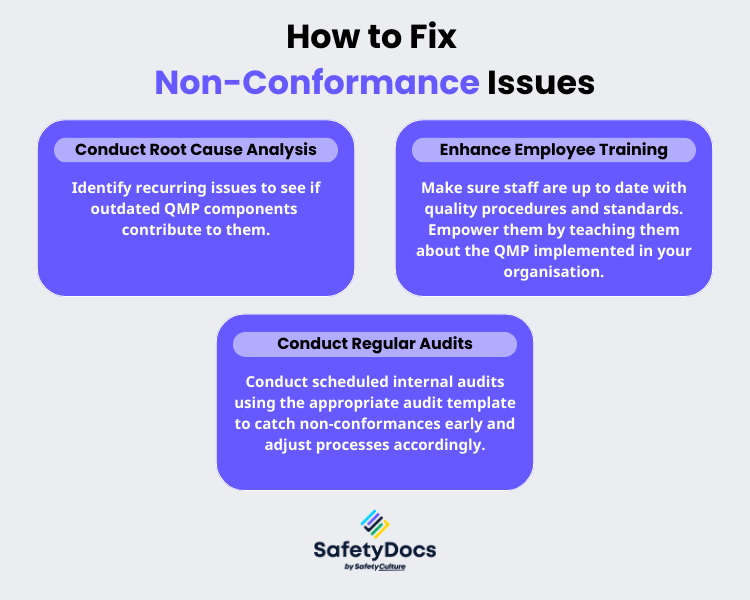A Quality Management Plan (QMP) is the foundation of any organisation’s commitment to maintaining high standards, regulatory compliance, and driving continual improvement. However, as businesses grow, industry regulations change, and customer expectations shift, even the most well-structured QMP can become outdated. In fact, many companies don’t realise their QMP is behind the curve until a failed audit, a spike in customer complaints, or an unexpected compliance notice forces them into reactive mode. Proactive monitoring and timely updates can prevent these costly surprises.
Importance of Updating Your QMP
If your QMP is outdated, it can cause bottlenecks in your operations, increase compliance risks, and hinder your business from delivering consistent quality. Without regular updates to your QMP, your business may struggle to meet new industry requirements, adapt to process improvements, or respond to changes in market demands.
Failing to update your QMP can also lead to inefficiencies and an increase in non-conformance incidents. Over time, these issues can erode trust with your business partners, impact profitability, and even result in regulatory penalties, all having a negative impact on business reputation.
To stay competitive and compliant, you must be proactive in assessing and refining your QMP. This guide explores 5 key signs that indicate it’s time for you to review and update your QMP and what actions you can take to ensure that your QMP, and your business, remain effective and relevant.
1. Increased Non-Conformance Issues
A rise in non-conformance incidents can indicate deeper issues within your quality management system. Whether it's due to unclear procedures, lack of employee awareness, or outdated compliance measures, these incidents can lead to increased costs, regulatory breaches, and operational inefficiencies. For example, a mid-sized food processing plant began experiencing repeated hygiene violations despite regular inspections; later traced back to outdated cleaning protocols that hadn’t been revised to meet new health codes.
Ignoring these warning signs can have a long-term impact on your business performance and reputation.
Why it Matters
A rise in non-conformance incidents signals gaps in your quality management processes. These issues can stem from outdated procedures, unclear guidelines, or insufficient training, leading to increased risks of non-compliance and operational inefficiencies.
How to Fix it
- Conduct Root Cause Analysis: Identify recurring issues to see if outdated QMP components contribute to them.
- Enhance Employee Training: Make sure staff are up to date with quality procedures and standards. Empower them by teaching them about the Quality Management System implemented in your organisation.
- Regular Audits: Conduct scheduled internal audits using the appropriate audit template to catch non-conformances early and adjust processes accordingly. Some organisations have found success pairing internal audits with 'quality spot checks,' where frontline staff identify minor issues in real time before they escalate.

2. Outdated Policies and Procedures
Regulations and industry standards change over time, and failing to keep your policies up to date can expose your organisation to non-compliance risks. As new legislation emerges, businesses must stay proactive in aligning their procedures with current best practices. Outdated policies can also create inefficiencies in daily operations, causing confusion among employees and inconsistencies in quality control measures.
Why it Matters
Regulatory requirements and industry standards evolve and failing to align your policies with these changes can result in compliance issues, legal risks, and inefficiencies in your operations. A construction company once faced a six-month project delay because its safety documentation did not reflect new scaffolding regulations, something that could have been avoided with a scheduled policy review.
Updating standards is such an important best practice that the Australian National Audit Office (ANAO) annually updates its Quality Management Framework and Plan in order to stay on top of ever-evolving quality risks and maintain its audit integrity.
How to Fix it
- Review Regulations Regularly: Stay up to date with industry guidelines, such as ISO 9001:2015, to ensure compliance.
- Schedule Periodic Policy Reviews: Set a regular cadence for updating policies and procedures based on industry best practices. This is especially critical for industries like healthcare or aviation, where outdated procedures can lead to immediate compliance failures and safety risks.
- Leverage Quality Management System (QMS) Templates: Utilise ready-made quality system templates to update your QMP and ensure consistency. Follow readily available guides like those made specifically for ISO 9001.
3. Feedback from Audits and Stakeholders
Audits and stakeholder feedback provide valuable insights into the strengths and weaknesses of your Quality Management Plan. If audit reports repeatedly highlight the same issues, or if employees and customers raise concerns about quality standards, these are obvious signs that QMP updates are needed. Addressing feedback proactively can help mitigate risks and reinforce your organisation's commitment to excellence.
Why it Matters
Audits and stakeholder feedback provide invaluable insights into potential weaknesses in your QMP. Ignoring these signals can lead to persistent inefficiencies and regulatory failures. When a tech company ignored repeated client feedback about inconsistent reporting formats, it eventually lost a major contract, highlighting that feedback is not just 'nice to have,' but vital to retaining business.
How to Fix it
- Analyse Audit Reports: Identify recurring issues and take corrective actions.
- Engage with Stakeholders: Regularly collect feedback from employees, customers, and regulatory bodies to improve processes in quality assurance and quality control. Consider publishing a 'You said, we did' report internally so employees can see how their feedback leads to change, which boosts buy-in for future quality initiatives.
- Implement Corrective and Preventive Actions (CAPA): Address concerns raised in audits proactively rather than reactively. Doing this also helps with continual improvement in quality.
4. Changes in Business Processes
As businesses grow and adopt new technologies, their operational workflows often change. Expanding into new markets, integrating automation, or modifying supply chain structures can all impact the effectiveness of your QMP. If your quality management framework does not evolve alongside these changes, you may face inefficiencies, communication breakdowns, and an inability to meet compliance requirements.
Why it Matters
Business expansions, technological advancements, and operational changes often render existing QMP frameworks obsolete. A manufacturer that moved to automated packaging found that its existing quality checks, designed for manual processes, were missing key machine calibration errors.
If your QMP doesn’t evolve with these changes, inefficiencies and compliance risks may arise. If most update their QMP yearly, you probably should, too.
How to Fix it
- Assess the Impact of Business Changes: Whenever there’s a major change, such as adopting new technology or restructuring teams, review your QMP for necessary updates. Pairing technical updates with refresher training ensures staff can adapt alongside systems, reducing errors during transitions.
- Integrate New Tools and Systems: Update your quality assurance and quality control processes to align with digital tools, automation, and data analytics.
- Communicate Changes Effectively: Make sure your employees understand changes through proper documentation and training.

5. Decline in Customer Satisfaction
Customer satisfaction is a direct reflection of your quality management system. A retail chain noticed negative reviews about inconsistent product sizing; updating their QMP to include tighter supplier checks and standardised measurements turned ratings around within six months.
If you notice an increase in complaints, product returns, or negative feedback, it may be one of the biggest signs your QMP needs updating. Poor quality control measures and outdated processes can erode customer trust, impacting brand reputation and long-term profitability. Ensuring your QMP is aligned with customer expectations can improve service delivery and product consistency.
Why it Matters
Customer complaints, declining reviews, or negative feedback often indicate underlying quality management issues. A well-maintained QMP should drive product and service excellence, improving customer trust and loyalty.
How to Fix it
- Monitor Customer Feedback Trends: Use surveys, reviews, and complaint logs to track patterns in customer dissatisfaction. Even small, visible improvements, like faster response times to complaints, can restore trust quickly.
- Adjust Quality Control Measures: Improve production processes, service protocols, or supplier relationships based on customer concerns.
- Commit to Continual Improvement: Implement an ongoing improvement cycle using tools like Plan-Do-Check-Act (PDCA) to enhance quality standards over time.
Be Proactive: Update Your QMP
A well-maintained Quality Management Plan is key to compliance, improving operational efficiency, and enhancing customer satisfaction.
If you notice any of these 5 signs in your organisation, it’s time to act and update your QMP. And even if you don’t see obvious signs, you’d rather be proactive and check your QMP if you haven’t done so in a while.
If you haven’t reviewed yours in the last year, schedule a formal review now, even if no problems are visible. Many issues only surface once they’ve already cost you time, money, or reputation.
Once you’ve identified the need for change, having the right resources on hand can make the process faster and far less disruptive. Instead of starting from scratch, you can lean on proven frameworks and templates that align with current standards, saving time while ensuring nothing important is missed.
Take Your Next Important Step
Is your Quality Management Plan meeting today’s standards? Explore our relevant QMP templates to streamline your updates and for your additional compliance resources.
Need expert guidance? Contact us for personalised advice on enhancing your quality management practices.
Our team of experts is dedicated to providing accurate and informative content. Craig Cruickshank, our senior HSEQ advisor at SafetyDocs by SafetyCulture has reviewed this blog post to ensure the highest level of quality.
Learn more about Craig's work on LinkedIn for more industry insights.
Available for instant download and supplied in fully editable MS Word format for use in your business.
Please note that the above information is provided as a comment only and should not be relied on as professional, legal or financial advice.
Share This Article
